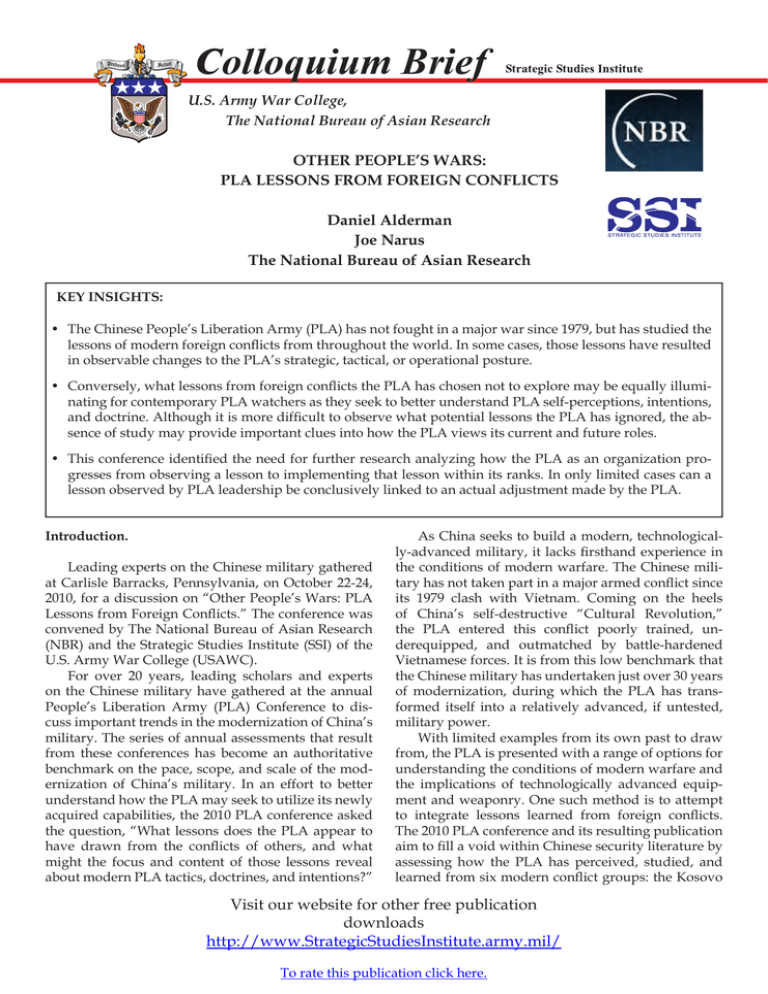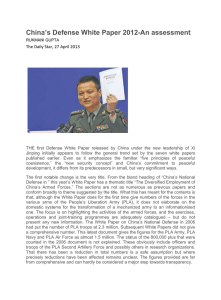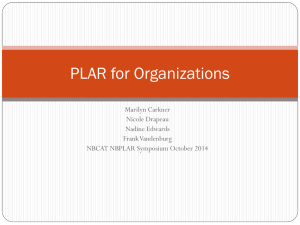Colloquium Brief
advertisement

Colloquium Brief U.S. Army War College, The National Bureau of Asian Research OTHER PEOPLE’S WARS: PLA LESSONS FROM FOREIGN CONFLICTS Daniel Alderman Joe Narus The National Bureau of Asian Research KEY INSIGHTS: • T he Chinese People’s Liberation Army (PLA) has not fought in a major war since 1979, but has studied the lessons of modern foreign conflicts from throughout the world. In some cases, those lessons have resulted in observable changes to the PLA’s strategic, tactical, or operational posture. • C onversely, what lessons from foreign conflicts the PLA has chosen not to explore may be equally illuminating for contemporary PLA watchers as they seek to better understand PLA self-perceptions, intentions, and doctrine. Although it is more difficult to observe what potential lessons the PLA has ignored, the absence of study may provide important clues into how the PLA views its current and future roles. his conference identified the need for further research analyzing how the PLA as an organization pro• T gresses from observing a lesson to implementing that lesson within its ranks. In only limited cases can a lesson observed by PLA leadership be conclusively linked to an actual adjustment made by the PLA. Introduction. Leading experts on the Chinese military gathered at Carlisle Barracks, Pennsylvania, on October 22-24, 2010, for a discussion on “Other People’s Wars: PLA Lessons from Foreign Conflicts.” The conference was convened by The National Bureau of Asian Research (NBR) and the Strategic Studies Institute (SSI) of the U.S. Army War College (USAWC). For over 20 years, leading scholars and experts on the Chinese military have gathered at the annual People’s Liberation Army (PLA) Conference to discuss important trends in the modernization of China’s military. The series of annual assessments that result from these conferences has become an authoritative benchmark on the pace, scope, and scale of the modernization of China’s military. In an effort to better understand how the PLA may seek to utilize its newly acquired capabilities, the 2010 PLA conference asked the question, “What lessons does the PLA appear to have drawn from the conflicts of others, and what might the focus and content of those lessons reveal about modern PLA tactics, doctrines, and intentions?” As China seeks to build a modern, technologically-advanced military, it lacks firsthand experience in the conditions of modern warfare. The Chinese military has not taken part in a major armed conflict since its 1979 clash with Vietnam. Coming on the heels of China’s self-destructive “Cultural Revolution,” the PLA entered this conflict poorly trained, underequipped, and outmatched by battle-hardened Vietnamese forces. It is from this low benchmark that the Chinese military has undertaken just over 30 years of modernization, during which the PLA has transformed itself into a relatively advanced, if untested, military power. With limited examples from its own past to draw from, the PLA is presented with a range of options for understanding the conditions of modern warfare and the implications of technologically advanced equipment and weaponry. One such method is to attempt to integrate lessons learned from foreign conflicts. The 2010 PLA conference and its resulting publication aim to fill a void within Chinese security literature by assessing how the PLA has perceived, studied, and learned from six modern conflict groups: the Kosovo Visit our website for other free publication downloads http://www.StrategicStudiesInstitute.army.mil/ To rate this publication click here. war, the Falklands/Malvinas conflict, the Iran-Iraq missile battles, the two U.S. Gulf Wars, today’s war in Afghanistan, and Russian small wars. A seventh paper examines how the PLA has studied and in some cases learned from the operations of the U.S. Pacific Command (PACOM). Conference organizers asked authors to analyze PLA lessons from each of these modern conflicts by answering the following questions: • What are the key observations that the PLA has drawn from the conflict about the nature and conduct of war? • Are there lessons in military doctrine, strategy, and training that were learned from this conflict? • What other unique lessons, perhaps in other fields, did the PLA learn by studying this conflict? • Are there observable adjustments that the PLA has made in response to the lessons learned? ported China’s traditional belief in the viability of a population-centric doctrine of “people’s war.” With the benefit of historical perspective, it now appears that these three contending schools do not need to be viewed as mutually exclusive; rather, each has manifest itself (to greater or lesser degrees) during the intervening 14 years of PLA modernization. First, China’s military has made significant investments and advancements in their development, acquisition, and deployment of high-technology weapons platforms. Second, in spite of its rapid military gains China has, by and large, carried out a cautious approach in its relations with the U.S. military. Finally, those advocating for the continued utility of “people’s war” in modern warfare continue to stress the need for welltrained personnel and the importance of political indoctrination, as evidenced by the National Defense Mobilization Act of 2010, which reaffirms the importance of civilians in modern warfare. Lessons Applicable to Conflict in the Taiwan Strait. Lessons from Air Campaigns. Of recent foreign conflicts, two are unique for the applicability of their lessons to a possible conflict over Taiwan: the Falklands/Malvinas conflict and the IranIraq “War of the Cities Dual.” Perhaps no conflict is more analogous to a potential Taiwan Strait crisis than the Falklands/Malvinas conflict, where the geographically distant but militarily superior British armed forces projected its power across thousands of miles of ocean to repel the technologically inferior Argentine military’s invasion of a near island. For China, this conflict offers a case study in the strategies, successes, and failures of the Argentine military as it attempted to deny British forces access to the waters surrounding the island(s). The lessons of this conflict have likely made a direct contribution to China’s anti-access/ area-denial (A2/AD) strategies currently presumed to be underway. Beyond lessons learned from the militarily weaker Argentinean perspective, China also appears to be studying operational lessons from the British military’s projection of power. These lessons are not only applicable to a Taiwan contingency, but also to a PLA that is slowly expanding its reach and commitments beyond the Chinese mainland and its periphery. During the Falklands/Malvinas conflict, Great Britain benefited from providing its own protection to a longdistance expeditionary force, maintaining access to overseas bases, and building a superior network of air power, merchant shipping, and amphibious forces. At the same time, Chinese commentators recognize the Over the past 3 decades, the Chinese military has made determined efforts to improve its offensive and defense air warfare capabilities. These efforts can be traced, at least in part, to the lessons China learned by studying U.S. offensive air warfare capabilities and tactics during the two Gulf Wars (1990, 2003) and the war in Kosovo, and by observing what defensive tactics worked or failed in the face of unrivaled U.S. air superiority and firepower. Conference papers explored what lessons China appears to have learned by studying these campaigns and shed light on the operational lessons that may inform future PLA deployments. In the years following NATO’s U.S.-led air campaign in Kosovo, three seemingly contradictory lessons have been articulated by different factions within the PLA. From one perspective, the war provided evidence that rapid military modernization focused on advanced technologies was the key to winning future conflicts. Accordingly, the PLA should focus on building a military whose strength and technological sophistication is equal to or greater than that of the United States. A second view suggested that in light of the sizable U.S. technological advantage, China should avoid an arms race with the United States, since it is unlikely to ever become a peer competitor. A final lesson was optimistic about the Federal Republic of Yugoslavia’s surprisingly robust defense against a superior opposition. This conclusion sup- 2 double sided nature of logistics, both as the most crucial factor for projecting power and as an “Achilles’ heel” to be exploited in modern warfare. The latest Department of Defense report on Chinese military power cites approximately 1,110 missiles deployed opposite Taiwan, not to mention the possible deployment of an anti-ship ballistic missile and an anti-satellite capability. Rapid progress within China’s missile sector implies that the use of missiles has become a principal tenet of the PLA’s overall force structure and perhaps the core element of PLA planning for a Taiwan scenario. Despite this central role in PLA planning, relatively little is known of how PLA leaders view other nation’s employment of conventional missiles. China surely sees a strong deterrence factor in their conventional missile force, but the PLA’s rapid missile modernization process may also be moving these weapons from only being objects of terror, to also being instruments with legitimate military utility. Therefore, in studying the history of these weapons, and particularly their use in the Iran-Iraq “War of the Cities Dual,” the PLA may have learned about the limits of conventional missiles to inflict knockout blows and to provide more than ineffective psychological terror on population centers. Thus, the PLA may not be emulating the use of conventional missiles in previous conflicts, but instead seeking to re-imagine the technological boundaries of these weapons so that they might play a wider military role than what has previously been employed. in nearly 40 years, its presence in China’s ocean fronts, as well as its massive organizational and power projection capabilities, offer Chinese commentators fertile ground for analysis. Both of the U.S. Gulf Wars have provided lessons for the PLA across a range of strategic, tactical, and operational level areas. One key theme running through the lessons derived from both of these conflicts is the importance of technology in modern conflict. This lesson is perhaps most clearly evidenced from the PLA’s study of the U.S. ability to relentlessly use precision guided munitions across a range of targets despite otherwise crippling climate and environmental conditions. In both conflicts, it was argued that the PLA saw this capability as dependent on the U.S. ability to utilize a range of advanced weaponry, and the PLA’s own procurement of cruise missiles, stealth aircraft, and attack helicopters was likely influenced by these decisions. Additionally, the PLA appears to have learned the lesson of the immense significance of communications and its impact on joint operations that so well served the U.S. military in the opening battles of Operation IRAQI FREEDOM. Interestingly, the importance of information technology appears to be a lesson that influenced Chinese leaders well beyond the PLA to include: Chinese commentators digesting lessons from these conflicts; Chinese political leaders; and the civilian population. This emphasis on technology at the strategic, tactical, and operational level has specifically elevated hightechnology information as the “key point” for modern warfare, with “information warfare” now seen in the PLA as a critical component to all levels of modern conflict, particularly as an issue of “perception management” within the military and civilian population. Unlike the two Gulf Wars, PLA commentators appear to have written significantly less about their lessons from PACOM operations. The most notable reason for the PLA’s unique approach to learning from PACOM is that it is viewed as a potential adversary. This means that there are aspects of PACOM as an organization and an implementer of modern warfare that the PLA likely wishes to model, but a paradox exists in that the PLA must make contingency plans to defeat that exact institution in the case of conflict with the United States. Thus, the PLA would intuitively not wish to integrate many of their lessons learned from PACOM, instead preferring to develop asymmetric capabilities capable of overcoming the militarily superior U.S. forces. With that said, the PLA seems to be learning lessons from PACOM on some noncombat areas, such as Lessons from U.S. Conventional Wars and Contingencies. The PLA has devoted considerable time and attention to understanding how the U.S. military wages its modern wars, and in this pursuit, no conflicts have been more influential in shaping the Chinese military’s thinking than Operation DESERT SHIELD in 1991 and Operation IRAQI FREEDOM in 2003. In learning from the most powerful military in the world, the PLA seems to have recognized that what was especially significant about these conflicts was their application of high-technology weaponry and tactics during a period of U.S. hegemony, which was free of the constraints that were present during the bipolar Cold War era. As the PLA learns from these two conflicts, it also appears to be going to great lengths to study how the U.S. military views operational contingencies in its Pacific Command (PACOM). Although PACOM has not had operational command of a war 3 the development of training centers, regional engagement, military diplomacy, humanitarian operations, and civil-military coordination. Although the level of PACOM influence from each of these areas likely varies greatly, despite considerable strain in the U.S.China military-to-military relationship, the PLA has still found areas of PACOM to partially imitate. winning the hearts and minds, as well as trust of the local population. In the meantime, evidence suggests that the PLA has learned the importance of eliminating insurgent leadership and the importance of limiting civilian casualties during COIN operations. Beyond Afghanistan, Russia is another neighbor that the PLA has studied extensively. The PLA appears to be learning a great deal from Russia’s experience in Chechen operations, which more closely models a regular war than the U.S. efforts in Afghanistan. In this regard, it seems evident from Chinese writings that the PLA is not currently prepared to fight and win a scenario similar to that of the Russian experience. In this respect, there seems to be great debate among PLA researchers over the efficacy of Russia’s firepower and its application in urban settings. This is as of yet a still largely unexplored area, which may prove influential on PLA thinking. Lessons from Counterinsurgencies and Small Wars. China is situated in a rough neighborhood that has experienced considerable local turmoil over the last 30 years. This reality has led the PLA to spend considerable time learning from regional conflicts, both for their proximity and their unique lessons. Perhaps the two most significant modern conflicts involving Chinese border countries include NATO’s operations in Afghanistan and Russia’s actions in Chechnya. In both cases, the lessons learned by the PLA and the People’s Armed Police (PAP) seem to be primarily focused on domestic contingencies. In looking toward the future direction of China’s own domestic operations, these two conflicts have proven to be most instructive for the Chinese. As U.S. forces in Afghanistan have shifted their focus toward conducting counterinsurgency (COIN) operations, so too has the PLA begun learning lessons from U.S. experiences with this style of conflict. Burdened with its own occasional acts of insurgency, the Chinese leadership no doubt hopes to learn from U.S. experiences in dealing with high-altitude operations that have utilized “network centric methods and equipment” to carry out both intelligence and surveillance operations, as well as attacks on adversaries. In the case of U.S. operations in Afghanistan, the PLA literature suggests that the Chinese leadership has primarily learned lessons at the tactical level, in areas such as battlefield fire support and the integration of unmanned aerial vehicles. One area identified in the literature that has seemingly received scant attention is on the question of whether the Chinese military could model U.S. efforts to integrate its civilian and military relationships into a unified COIN strategy. This as of yet unexplored area would shed light on whether the Chinese military is prepared to adapt to a style of civil-military integration that the U.S. military feels is essential to Conclusion. Many questions remain over the pace, scope, and scale of the PLA’s future modernization efforts. In an effort to better understand the priorities of this program, this conference addressed areas in which the Chinese military might be drawing lessons from the experiences of others. This inquiry indicated that while it is often difficult to conclusively link a specific aspect of PLA modernization to a lesson learned from abroad, the conference’s presentations and discussions did show that the PLA has devoted substantial time and energy to the study of others. Lessons learned from abroad will almost certainly continue to shape the course of China’s military modernization. ***** The views expressed in this brief are those of the authors and do not necessarily reflect the official policy or position of the Department of the Army, the Department of Defense, or the U.S. Government. ***** More information on the Strategic Studies Institute’s programs may be found on the Institute’s homepage at www.StrategicStudiesInstitute.army.mil. 4



